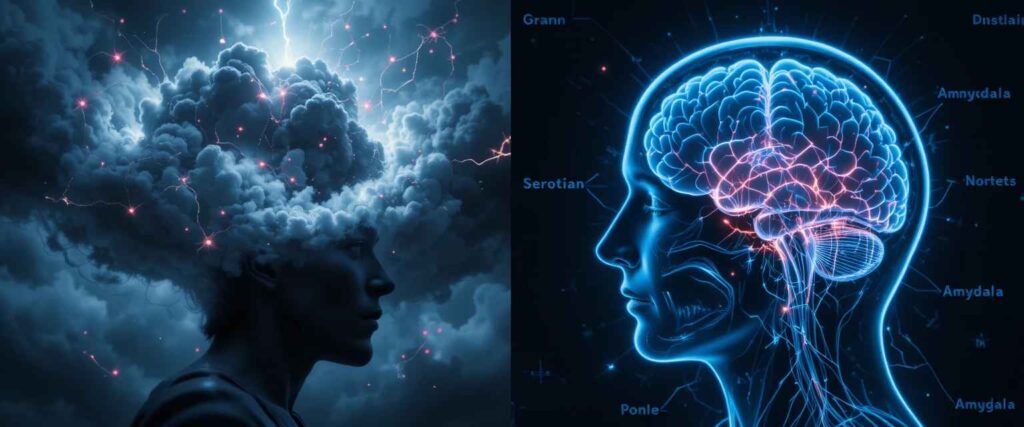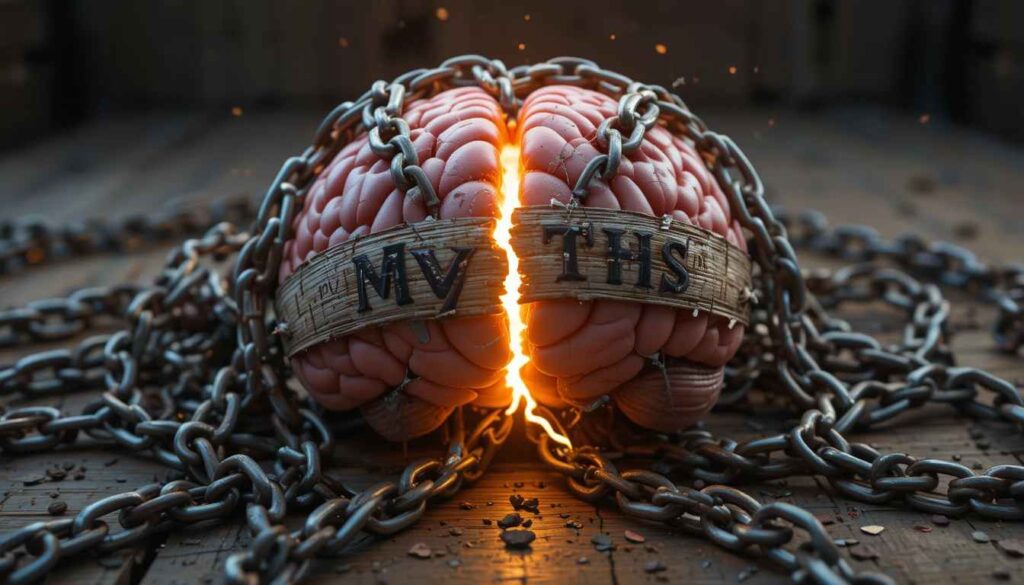Introduction
Let’s talk about anxiety myths—those well-meaning but dangerously wrong ideas that float around like “facts.” You’ve probably heard them a thousand times: “Anxiety is just overthinking,” “Only weak people struggle with it,” or “Just avoid stress and you’ll be fine.” These myths don’t just spread misinformation; they gaslight millions into silence, trivialize real struggles, and worst of all, keep people from seeking help. But here’s the truth: Anxiety isn’t a personality flaw, a phase, or something you can “positive vibes” away. It’s a complex, human experience with biological roots, and believing these common anxiety myths only deepens the stigma. Ready to shatter the stigma? Let’s reveal what’s actually true—and how to reclaim your peace of mind.
Imagine this: You’re scrolling through Instagram, and your friend posts, “Anxiety is just laziness in disguise.” Your chest tightens. You’ve heard this before—from coworkers, family, even memes. But here’s the truth: Anxiety isn’t a character flaw, a lack of grit, or something you can “snap out of.” It’s like having a fire alarm stuck in your brain that screams “EMERGENCY!” even when there’s no fire.
The problem? Myths about anxiety don’t just spread misinformation—they make people feel guilty for struggling. Let’s smash these falsehoods with a sledgehammer and replace them with science, empathy, and real talk.
Myth 1: “Anxiety Isn’t a Real Illness—It’s Just Overthinking”

The Myth:
“You’re just being dramatic.”
Why It’s BS:
Imagine telling someone with a broken leg, “Just walk it off!” That’s what this myth does. Anxiety isn’t “overthinking”—it’s your brain and body teaming up in a biological panic.
The Science, Simplified:
- Your amygdala (the brain’s alarm system) goes haywire, flooding your body with adrenaline.
- Your prefrontal cortex (the logical CEO) gets drowned out. That’s why you know the plane won’t crash, but your body acts like it’s certain.
- Physical symptoms are real: Think shaky hands, nausea, or feeling like you’re choking.
What to Say Instead:
“This sounds exhausting. How can I help?”
Myth 2: “Avoid Stressful Situations to Cure Anxiety”

The Myth:
“Just quit your job!” “Stay home where it’s safe!”
Why It’s BS:
Avoidance is like putting a Band-Aid on a broken bone. Skipping that work meeting? It gives temporary relief but teaches your brain, “Yep, that was life-threatening!” Next time, the fear feels even bigger.
A Better Approach:
- Baby steps: If parties trigger you, start with a 10-minute coffee date. Celebrate showing up, even if you leave early.
- Therapy hack: Exposure therapy isn’t about “facing your fears”—it’s about proving to your brain, “Hey, I survived this. Maybe it’s not so scary?”
Real-Life Win:
Jake avoided driving for years after a panic attack. His therapist had him sit in his parked car for 5 minutes daily. A month later, he drove to the grocery store. “It wasn’t about courage,” he says. “It was about trust.”
Myth 3: “Only Weak People Get Anxious”

The Myth:
“Toughen up!”
Why It’s BS:
Anxiety doesn’t care if you’re a CEO, a pro athlete, or a kindergarten teacher. Even superheroes like Wonder Woman’s Gal Gadot and Batman’s Christian Bale have talked about their anxiety.
The Truth:
- Anxiety ≠ weakness: It’s often a sign your body is working overtime to protect you.
- Genetics matter: If your parent has anxiety, you’re 30% more likely to develop it, says the NIH.
What to Do:
Swap “Why can’t I handle this?” with “What do I need right now?”
Myth 4: “Medication Is the Only Way to Fix Anxiety”
The Myth:
“Just take a pill and move on.”
Why It’s BS:
Medication helps millions, but it’s not a magic wand. Healing anxiety is like baking a cake—you need multiple ingredients.
The Recipe:
- Therapy: CBT (cognitive behavioral therapy) helps rewire anxious thoughts.
- Lifestyle tweaks: Walking 20 minutes a day can lower cortisol (the stress hormone).
- Community: Support groups remind you, “I’m not the only one.”
A Patient’s Story:
Maria tried SSRIs but still felt stuck. Adding daily yoga and a “Worry Hour” (where she journaled fears at 4 PM) changed the game. “Now I tell my anxiety, ‘You’ll get your turn later.’”
Myth 5: “If You Have Anxiety, You’ll Never Live a Normal Life”
The Myth:
“You’ll always be held back.”
Why It’s BS:
Anxiety is a part of your life—not the whole story. People with anxiety climb mountains, raise kids, and host podcasts (looking at you, Brené Brown).
Tools That Help:
- Grounding: Press your feet into the floor. Name 3 things you see. You’re back in your body.
- Boundaries: “I can’t make that event, but I’ll text you tomorrow!”
Inspiration:
Author Glennon Doyle writes, “Anxiety is a sensitive friend—she’s just trying to keep you safe.”
Myth 6: “Anxiety Always Stems from Trauma”
The Myth:
“You must have had a terrible childhood.”
Why It’s BS:
Sometimes anxiety pops up like an uninvited party guest—no trauma required.
Surprising Triggers:
- Gut health: Your gut produces 90% of your serotonin (the “happy chemical”). An unhappy gut = an anxious mind.
- Hormones: PMS, perimenopause, or thyroid issues can mimic anxiety.
What to Try:
- Keep a symptom journal. Notice patterns like “I feel worse after eating gluten” or “Anxiety peaks before my period.”
- Talk to a doctor—it might not be “just anxiety.”
Myth 7: “Kids Don’t Get Anxiety—They’re Just Shy”

The Myth:
“She’ll grow out of it!”
Why It’s BS:
1 in 8 kids has an anxiety disorder. Ignoring it is like ignoring a fever—it won’t just go away.
Signs in Kids:
- Meltdowns over tiny changes (e.g., a different breakfast cereal).
- “Clumsy” excuses to skip school (“My tummy hurts!”).
- Perfectionism: Erasing homework until the paper tears.
How to Help:
- Play it out: Use dolls to act out scary situations. “What would Dolly do if she’s nervous?”
- Normalize feelings: “Even superheroes get scared. Let’s brainstorm what helps!”
Read More About:
- How to Overcome Social Anxiety | What Social Anxiety Really Feels Like (It’s Not Just “Shyness”)
- The Root Cause of Social Anxiety: Why Your Brain Thinks Everyone’s Judging You
FAQs
- “How to calm anxiety fast?”
- 5-4-3-2-1 Technique: Name 5 things you see, 4 you feel, 3 you hear, 2 you smell, 1 you taste. It forces your brain to focus on the present.
- Cold water splash: Triggers the “dive reflex,” slowing your heart rate.
- “Can anxiety cause chest pain?”
Yes! Anxiety tightens chest muscles and spikes adrenaline. Rule out heart issues first, but know it’s common. - “What foods reduce anxiety?”
- Dark chocolate: Boosts serotonin.
- Chamomile tea: Natural sedative.
- Probiotics: Yogurt or kimchi for gut-brain harmony.
- “Is anxiety genetic?”
Partly. You might inherit a sensitive nervous system, but coping skills (learned!) matter more. - “Can anxiety make you throw up?”
Absolutely. Your gut and brain are besties. Anxiety can trigger nausea, IBS, or even vomiting. - “How long do anxiety attacks last?”
Usually 10-30 minutes. If it lasts hours, it’s likely a wave of multiple attacks. - “Can exercise help anxiety?”
Yes! Exercise burns off adrenaline and releases endorphins. Even a dance party in your kitchen counts. - “What’s the difference between anxiety and stress?”
- Stress: “I’m overwhelmed by this deadline.”
- Anxiety: “What if I fail, get fired, and end up homeless?” (Worst-case spiral).
- “Can you die from anxiety?”
No—but it feels like you might. Panic attacks aren’t deadly, though they’re terrifying. - “How to sleep with anxiety?”
- Weighted blanket: Mimics a hug, calming your nervous system.
- Write it down: Dump worries on paper before bed. “I’ll deal with you tomorrow.”
Conclusion: You’re Not “Too Much”
Let’s end with a truth: Anxiety doesn’t make you broken—it makes you human. It’s okay to need help, to cancel plans, or to cry in the Target parking lot.
Your job isn’t to “fix” yourself. It’s to learn your triggers, find your tools, and treat yourself like you’d treat a best friend: with patience, humor, and a lot of grace.
Remember: The bravest thing you can do is ask for help. So text that therapist. Try the weird breathing app. Buy the weighted blanket. You’ve got this.

GREAT